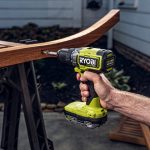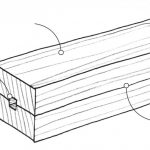We may receive a commission when you use our affiliate links. However, this does not impact our recommendations.
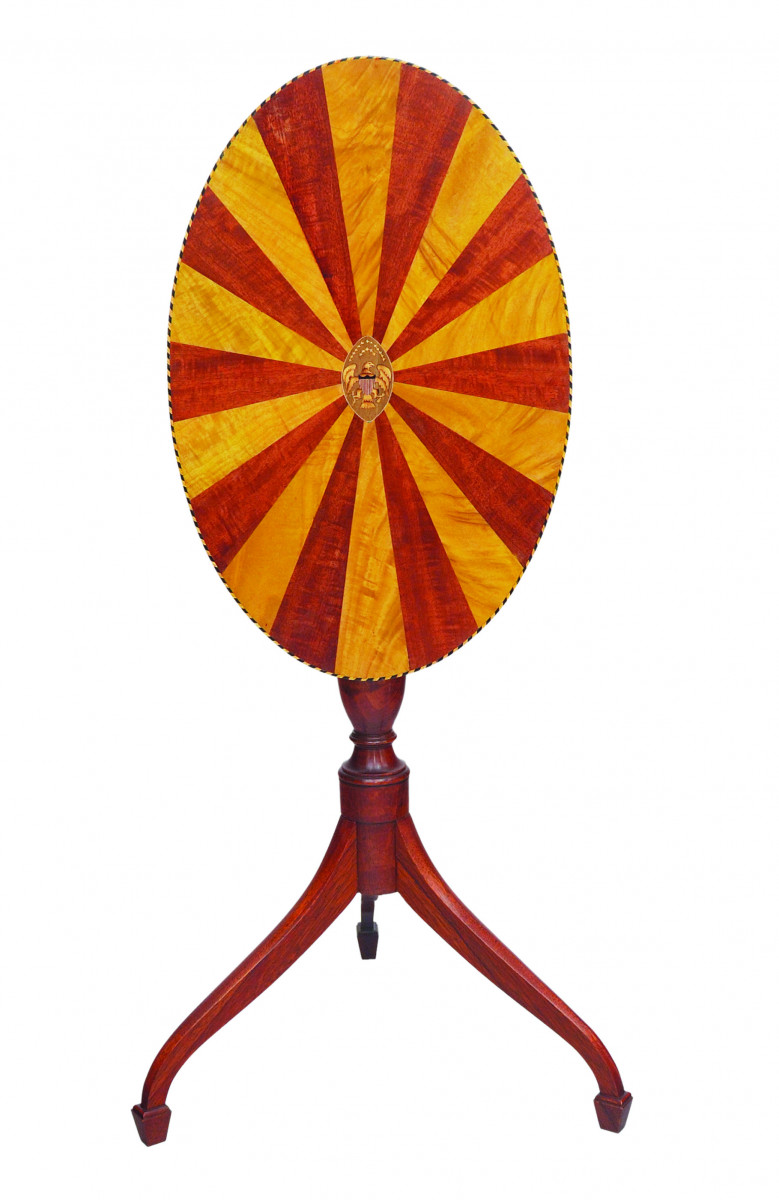
A showcase for veneer. An upsurge in veneer usage presented more options for woodworkers. This candlestand’s top would be all-but-impossible to create out of solid hardwood.
Years ago I discovered Federal furniture and knew that with beautiful veneer, superb inlay and simple carving, this would be my furniture period of choice.
Federal furniture has much to offer woodworkers. In addition to the traditional
joinery, there is veneering, inlay (stringing, banding as well as pictorial), reeding, curved work and some carving. Initially it was the rigid symmetry that drew me to the style – followed closely by the lavish use of highly figured woods. (What woodworker doesn’t appreciate beautiful wood?)
Of course, the defining features of Federal furniture are the veneers and inlays. Veneers had been a feature of William & Mary furniture, and a limited amount of veneer and inlay work occurred during the Queen Anne and Chippendale periods, but nothing like on the scale seen during the Federal period (1785 – 1810).
The Attraction of Veneer
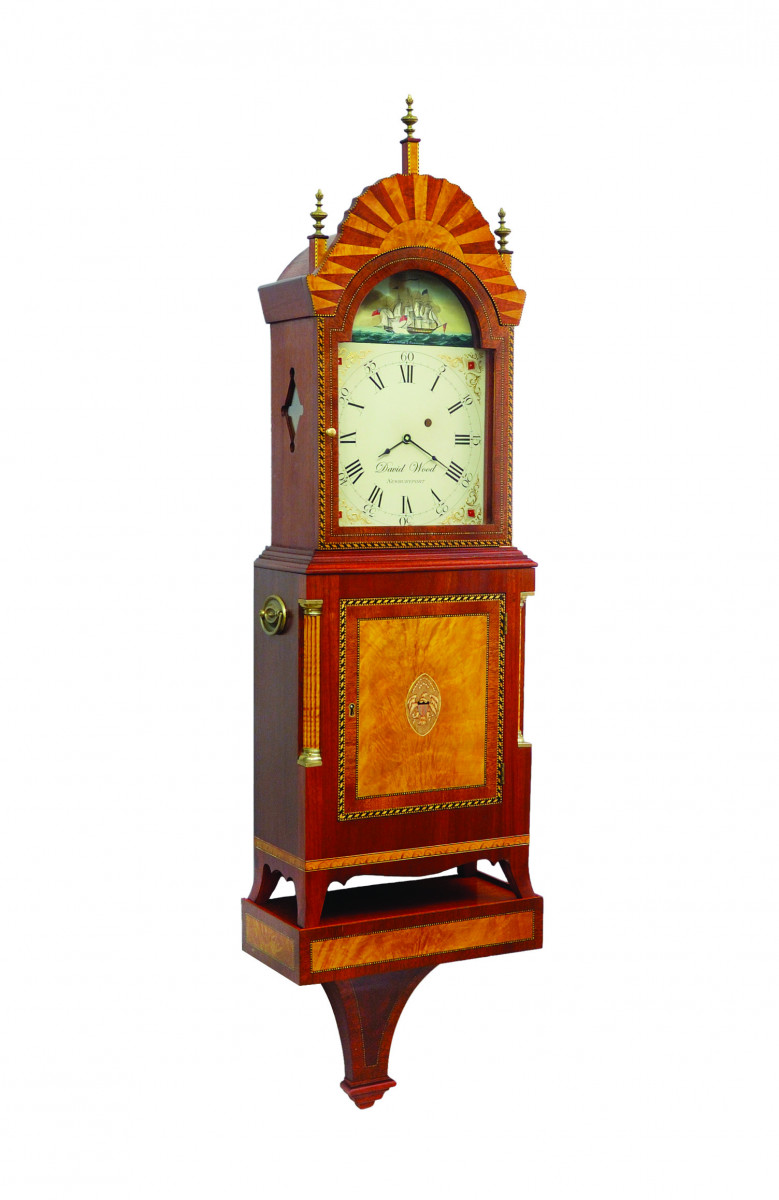
Federal period woodworking. This shelf clock exhibits many attributes of Federal furniture design. The use of veneer and inlay work (bandings, stringing and a pictorial inlay) signaled a transition from Queen Anne and Chippendale furniture.
The expansion of American trade in the 18th century delivered many exotic and beautiful veneers. Cabinetmakers of the period certainly explored the use of those veneers. Veneers were used with dramatic effect to decorate surfaces in geometric patterns or those surfaces were used as a pallete to display highly figured veneers. Often these veneers were outlined with stringing or bandings of multiple contrasting woods.
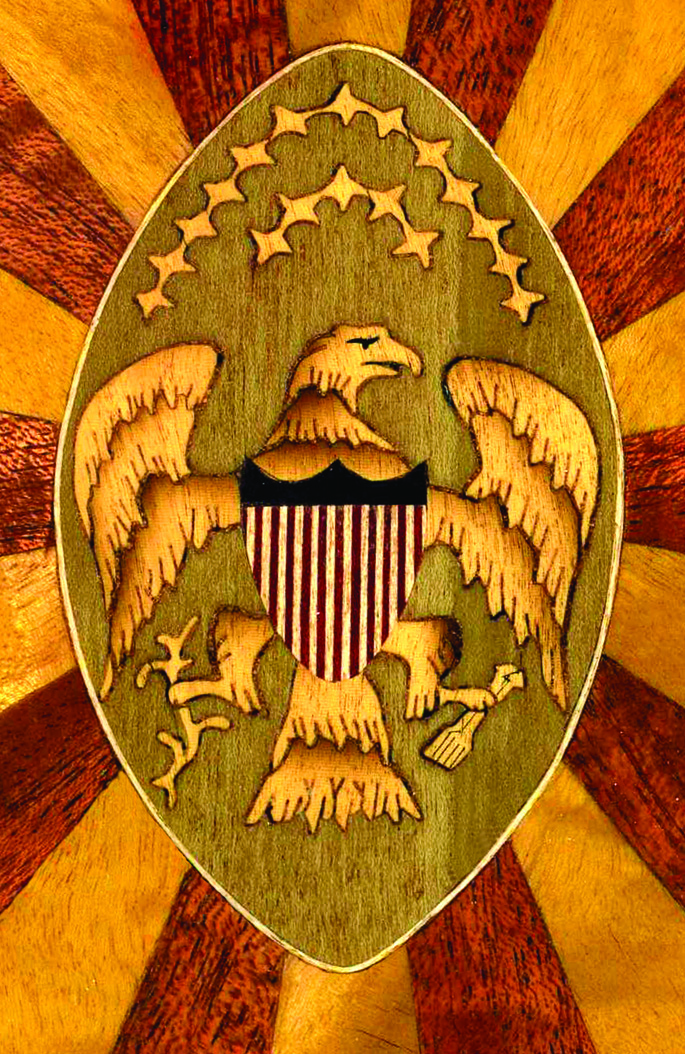
Pictures in wood. Different veneer species and/or dyes, along with sand shading, give this inlay depth and “pop.” Notice the fine, engraved lines that define the arrows held in the eagle’s claw.
At first I had only a vague understanding of what veneering was, but the idea of being able to use thin sheets of wood, hide glue and a veneer hammer to produce striking furniture façades fascinated me. Today, that process still has me in its grip; there is nothing like it.
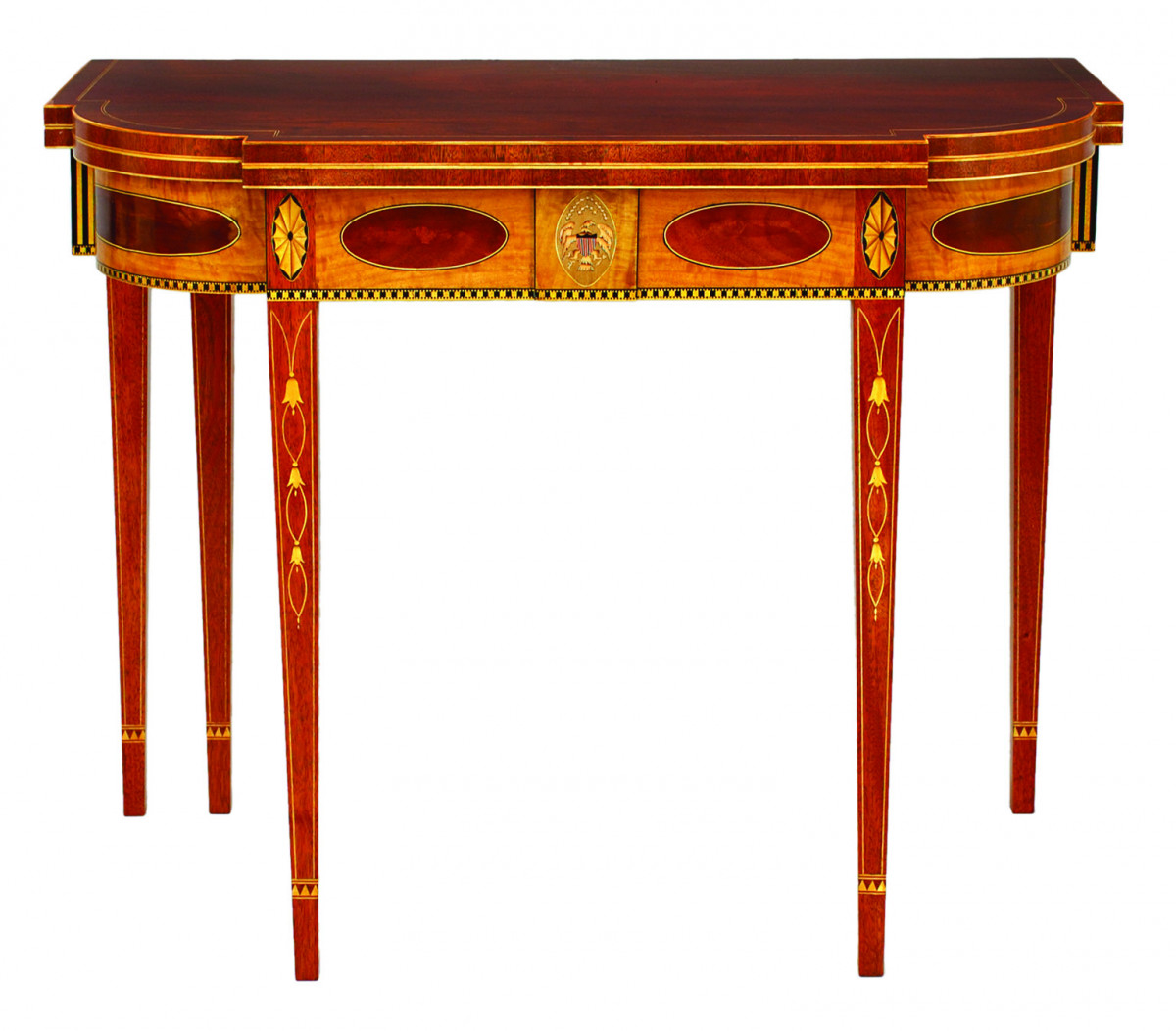
Some curves included. Though often thought of as linear in design, Federal furniture exhibits plenty of curves. This card table design uses an oval veneer inlay accented by twin stringing to highlight the curves.
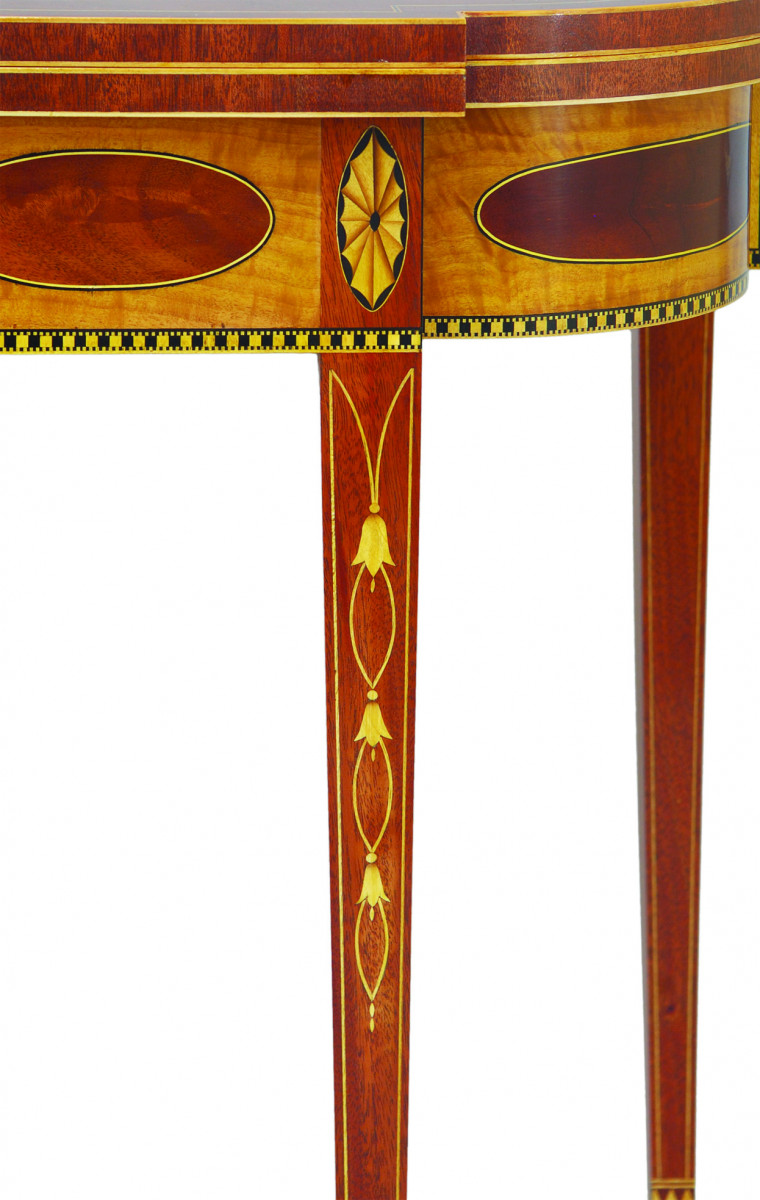 Veneering is actually an easy way to decorate a beautiful piece of furniture because Mother Nature has done the hard part by creating such diverse species and impressive grain patterns. Veneering also allows you to create objects that wouldn’t be possible in solid wood – the sunburst pattern on the candlestand shown on the previous page, for example – and work with species not commonly available as thicker lumber.
Veneering is actually an easy way to decorate a beautiful piece of furniture because Mother Nature has done the hard part by creating such diverse species and impressive grain patterns. Veneering also allows you to create objects that wouldn’t be possible in solid wood – the sunburst pattern on the candlestand shown on the previous page, for example – and work with species not commonly available as thicker lumber.
Bandings, Paterae and Stringing
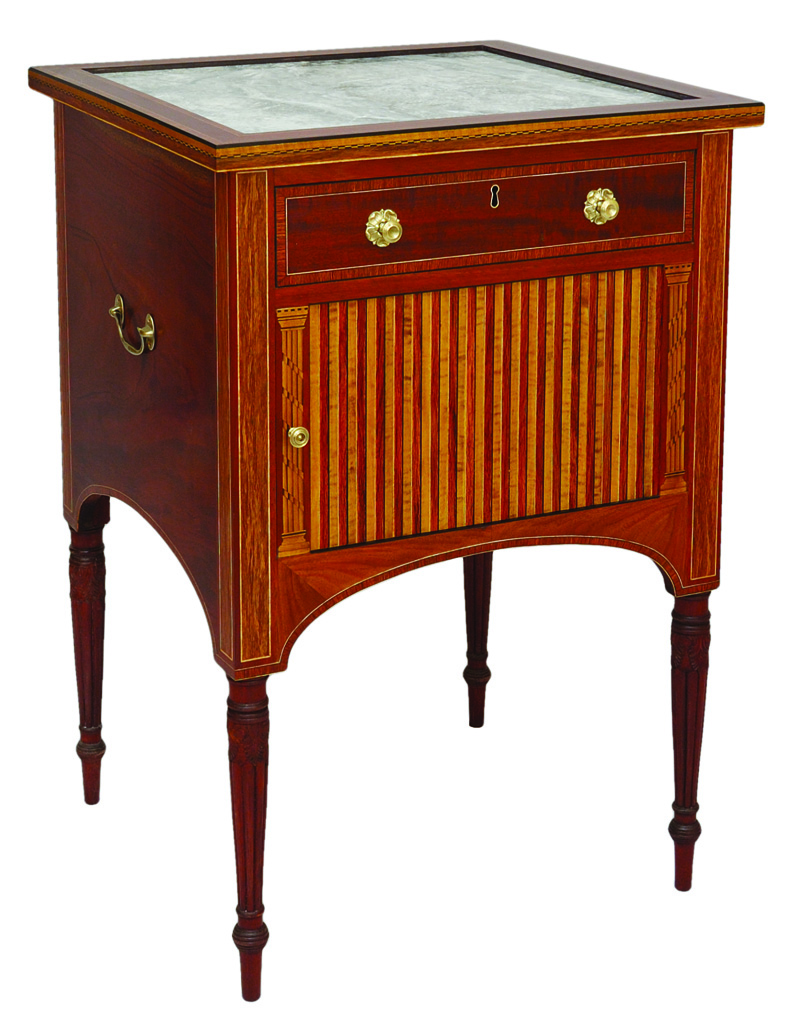
Not just for straight lines. This basin stand (above) demonstrates the importance of string inlay. When wrapped around other inlay or used to define edging, stringing focuses your eye and influences the design.
Equally interesting are the bandings. These display an astounding level of craftsmanship, especially when viewed in light of the conditions under which period craftsmen worked. I appreciate the geometry of bandings. It gives me an opportunity to do precise work and apply some creativity in their production, plus there is the satisfaction of producing what looks to be incredibly detailed works of art.
Like most people, when I first saw the bandings on Federal furniture, I couldn’t understand how they were made. I envisioned having to glue many small pieces directly onto a workpiece. In truth they are quite easy to make as a block with individual strips sawn off before being inlaid. It’s a toss-up as to whether making bandings or veneering is my favorite aspect of this period.
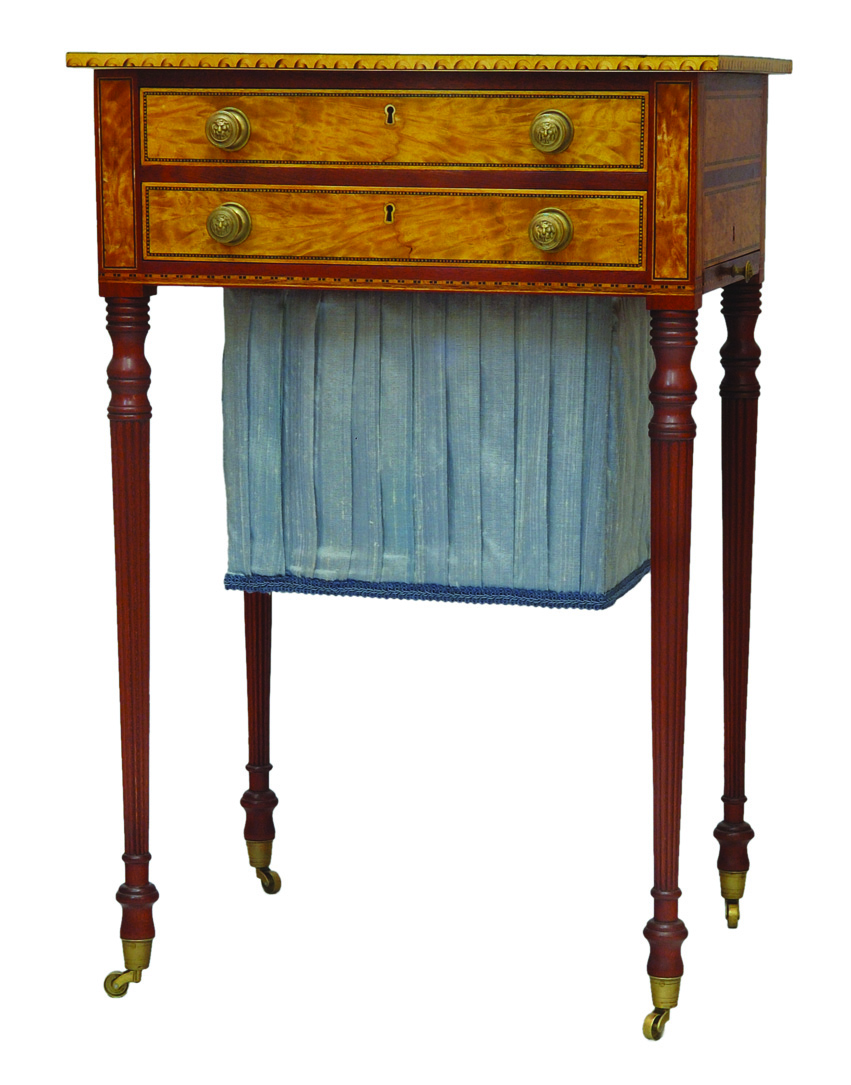
Only simple carving required. Most Federal furniture has little figural carving, but the reeding on the legs is one form of carving that’s found in abundance.
Rivaling these bandings are the pictorial inlays known as “paterae.” Pictorial inlays are a common feature of the Federal style and range from fans to shells and more. Many are incredibly artistic. Standing out among these pictorial inlays are the eagles that adorn many pieces. These are among my favorites, but conch shells are also impressive.
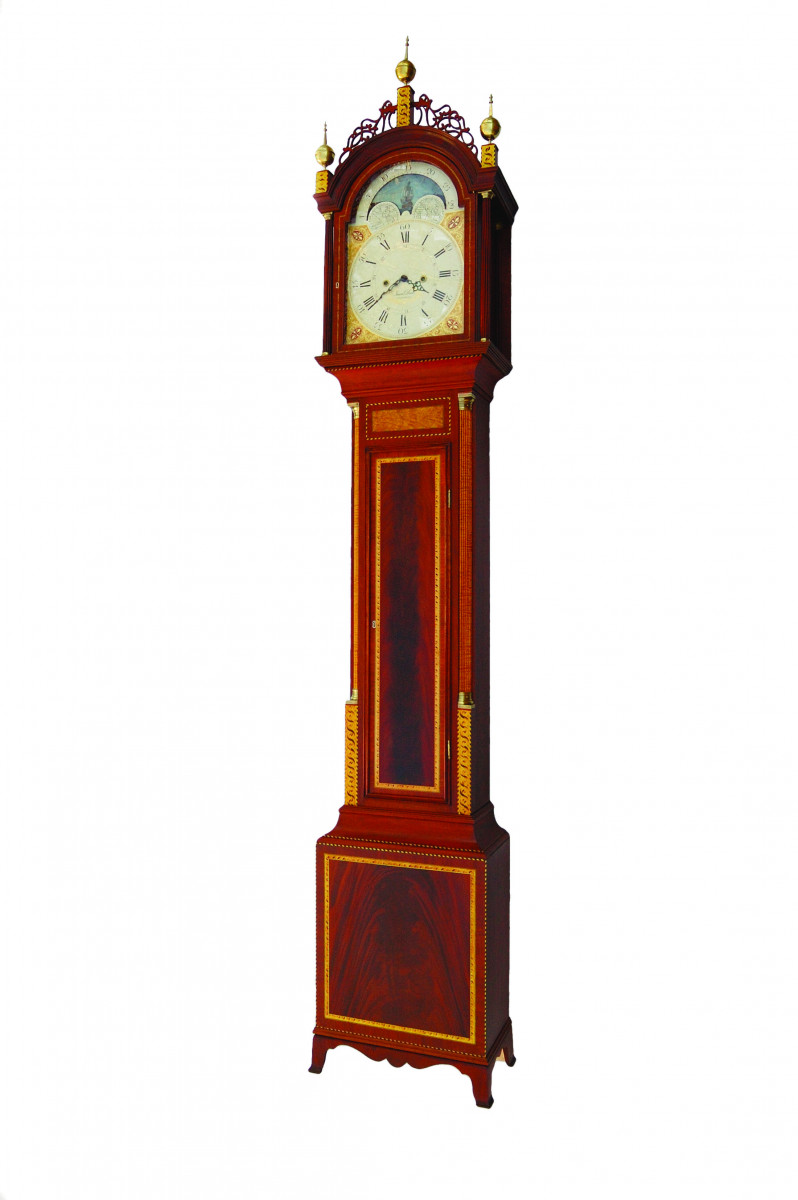
Up-to-the-minute design. Antique tall-case clocks bear the name of the maker of the movement, but most clocks are collected by museums for their importance as furniture. The maker of the antique clock that I copied mixed the veneer species and special bandings to make this design a Federal masterpiece.
While not common, some inlays are further enhanced by engraving fine lines and filling those lines with a mixture of lamp black and glue. And, from the standpoint of simplicity of construction yet with a formal appearance, nothing equals the various forms of a sand-shaded fan. I’m continually in awe of the way sand shading adds so much depth and brings these inlays to life.
Second only to veneer in the ease with which it enhances a piece of furniture, is stringing. Stringing is narrow strips of wood, either solid or multiple layers of contrasting species, used to set off various veneered elements, to accentuate the shape of components, or as geometric, decorative ornamentation.
Federal Has Curve Appeal
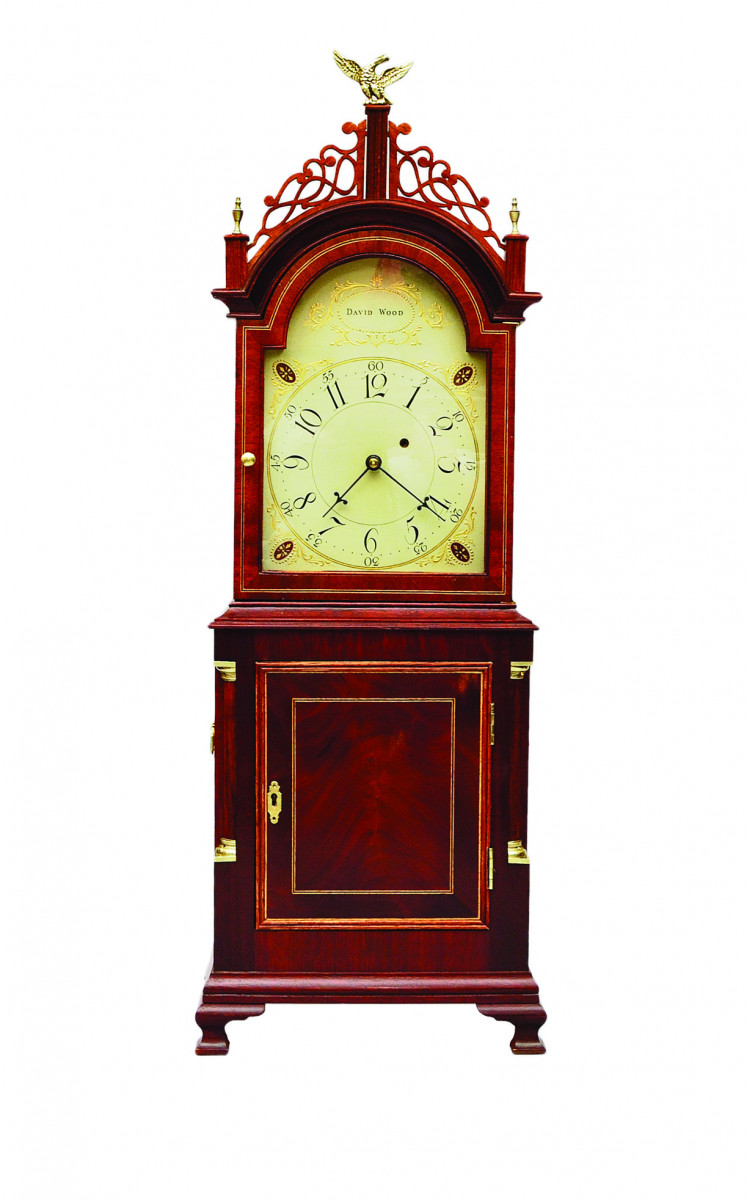
Dynamic duo. Combinations of veneer and stringing were used to enhance projects. Both clock doors are veneered. The lower door is most obvious with a panel set inside the string. But under close scrutiny, the upper door reveals the entire frame is covered with edge banding.
Curves abound in Federal furniture, and they run the gamut from the gentle, such as those on a bow-front chest, to the bold, found on sideboards and card tables. Making these curved pieces is certainly a challenge, but the effort is rewarded with a piece of furniture of great visual interest that befits a true craftsman. Here again the veneering plays an important role in these curves, many of which, if made in solid wood, would either be impossible due the unstable nature of the species, or the grain pattern would take on an unnatural look from the undulating shapes.
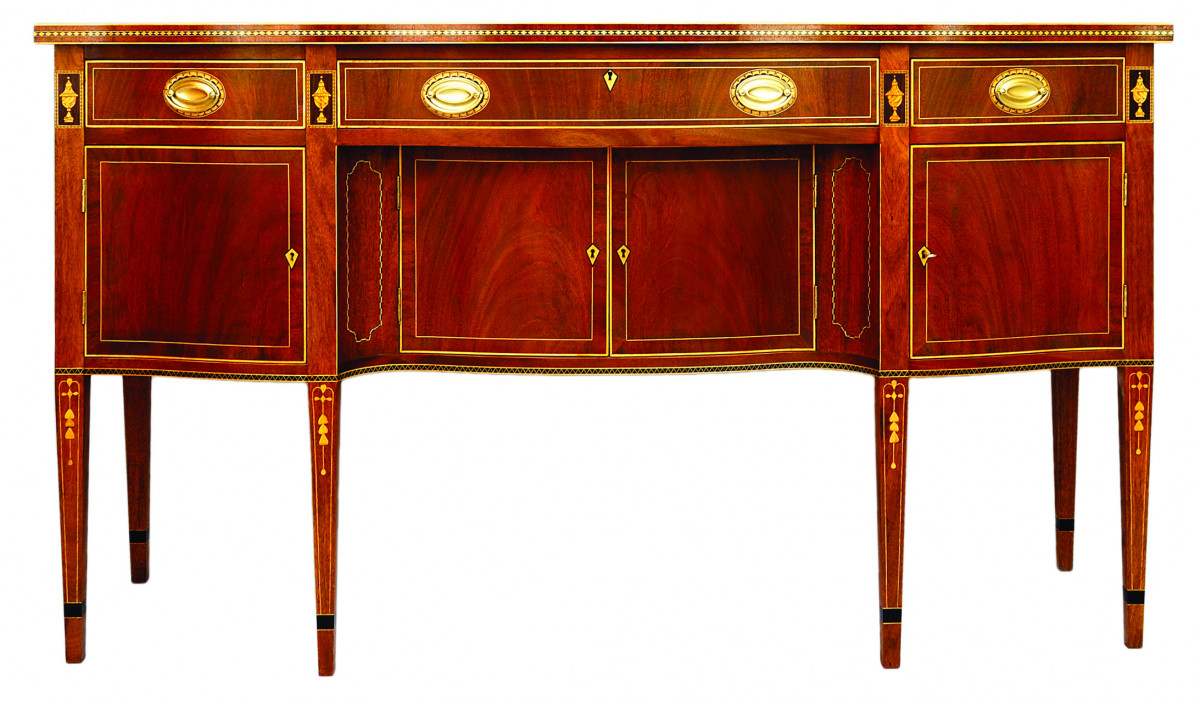
You can’t help but notice. Sideboards, not found in homes prior to the neoclassical period, became the focal points in many dining rooms and these stately pieces included many of the period’s woodworking characteristics.
Last but not least on the list of features that drew me to Federal furniture is the overall lack of carving – which matched nicely with my lack of carving skills. What carving there is, with few exceptions, is not the fluid foliage carving typical of the Chippendale period, but keeps with the geometric nature of Federal furniture. And that also suits me.
Falling loosely in the carving category is the reeding on the legs of late Federal-period pieces. Despite my lack of enthusiasm for carving, I do enjoy reeding a turned leg due to the sense of elegance the finished legs impart.
From the Beginning
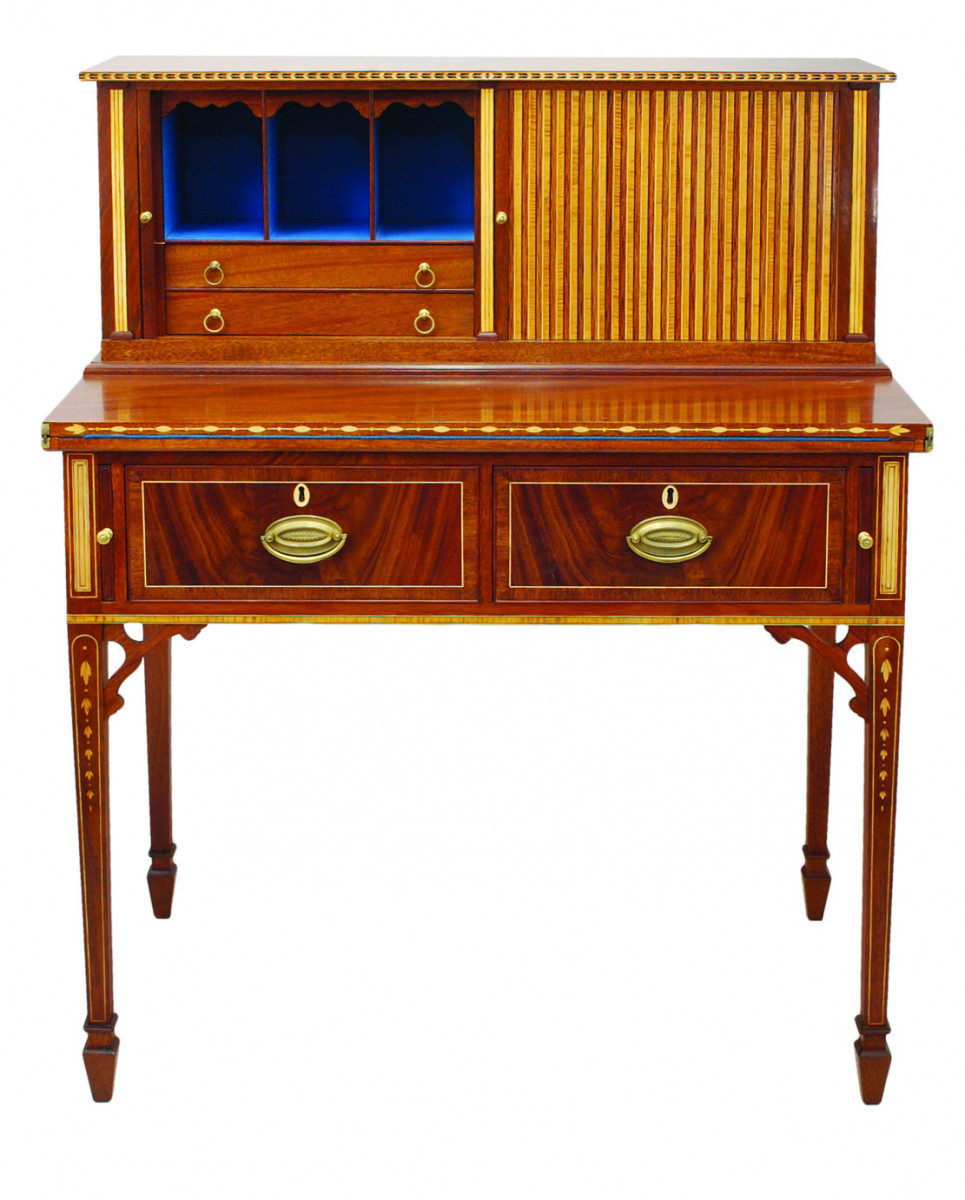
Slimmer legs. Cabriole legs (found on many Queen Anne and Chippendale pieces) were cast aside and replaced with delicate, tapered legs at the advent of the Federal period.
No discussion of this period would be complete without a little of history behind the style. This is another aspect I enjoy, because it combines my interest in history with the woodworking.
The Federal period coincided with the emergence of our Republic, but its origins were in the mid-18th century, with the discovery of ancient Greek and Roman ruins. Interpretations of these discoveries were the rage in all of Europe.
Among the most prolific designers to embrace this new style was Robert Adam who, along with his brother, published “Works in Architecture” in 1773. This book was very influential and signaled the demise of the Rococo style.
This new style, referred to as Neoclassical, was refined even further during the next decade or so and these changes were displayed in the published works of George Hepplewhite (1788) and Thomas Sheraton (1791-94). The influence of these two men was so great that their names now define the style.
Although we had won our independence from England, the country’s influence was still pronounced. So naturally, what became popular in England was adopted here – although somewhat later and with our unique interpretation. Americans, with their new-found independence, were drawn to this style not only because of the influence from England, but also the perceived connection between our new republican government and those of the Romans and Greeks.
A New Wave of Design
American Neoclassical furniture is generally less ornate than its English counterparts and, like the Queen Anne and Chippendale furniture before it, was typically more vertically oriented. The changes were so significant that this new style became known as “Federal,” referring to our then-new Federal republic.
When the Queen Anne style was supplanted by Chippendale designs, the change was minimal and fairly gradual; the types of furniture remained constant and only the surface ornamentation and perhaps the boldness changed. In contrast, the Federal/Neoclassical style changed everything, and quickly. Characterized by symmetry and lightness, Federal furniture must have been a shock when first shown, and even today it looks quite modern, rivaling current studio furniture.
Gone for the most part is carving, and what carving remains is more delicate. The cabriole leg with ball and claw feet that dominated the Chippendale period aren’t found on Federal pieces; instead, delicate tapering legs and later, turned and reeded legs dominate the style.
Gone too are the bold mouldings, replaced with more rectilinear shapes. That does not mean complex shapes are not to be found. Indeed, many pieces display an abundance of curves yet are still refined and delicate in appearance. There are pieces of Federal furniture that when stripped of any surface ornamentation, are quite simple and similar in design to Shaker furniture.
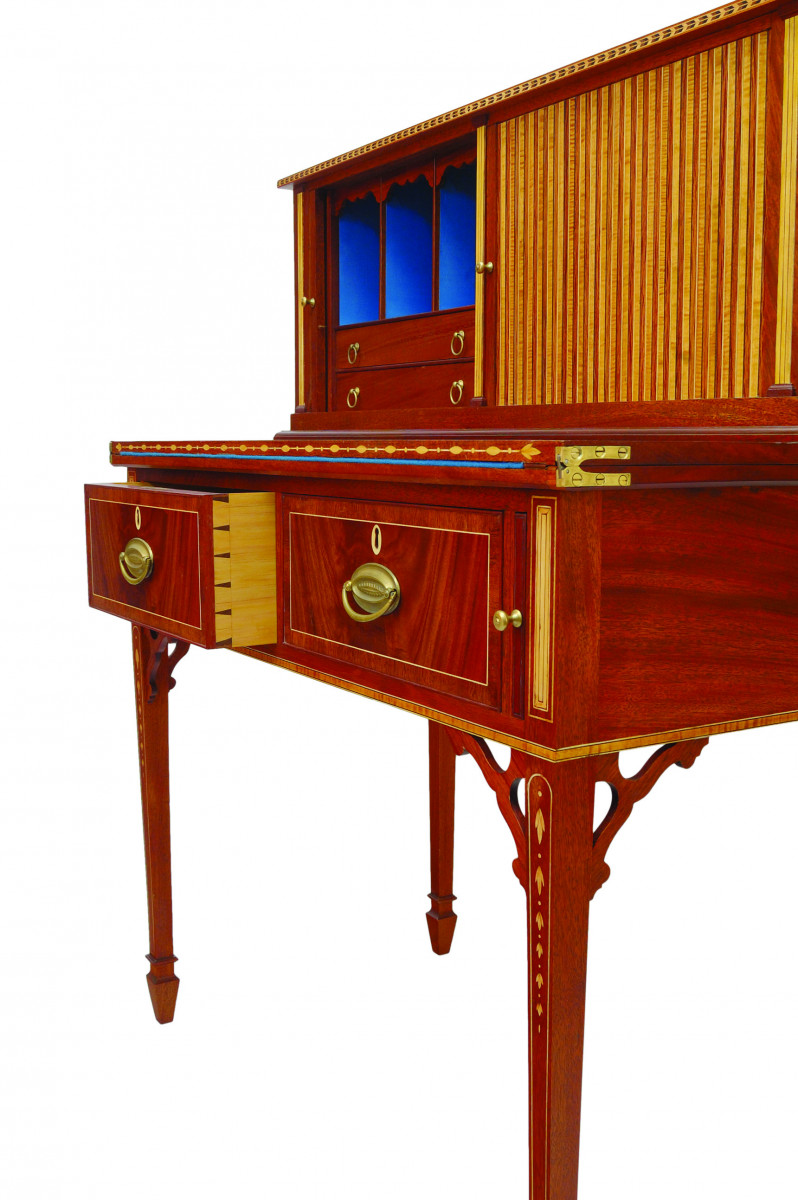
Skill and expertise. Details of this desk, originally built by well-known Federal furniture makers John and Thomas Seymour, illustrate the exquisite craftsmanship of the period.
In addition to the new style, some new furniture types appeared at the beginning of the Neoclassical period, or became more prevalent. Sideboards, unheard of before this period, became a focal point of the dining room, and were often imposing pieces with complex curved facades, adorned with a full range of Neoclassical details. The proliferation of worktables reflected the increased influence of women in the home. Card tables certainly existed before the Federal period, but they reached their zenith during this period, with nearly endless variations of shapes and levels of ornamentation.
In the end, the thing I enjoy most about Federal furniture is putting myself in the shoes of the original craftsman and trying to imagine the “how” and “why” of their techniques and designs. They worked without good lighting, having never heard of the band saw, router (there are times when I wish I hadn’t heard of this tool), surface planer, or random-orbit sander. My respect for those craftsmen and their furniture only deepens and I find the shoes don’t really fit – they are too big.
Here are some supplies and tools we find essential in our everyday work around the shop. We may receive a commission from sales referred by our links; however, we have carefully selected these products for their usefulness and quality.








